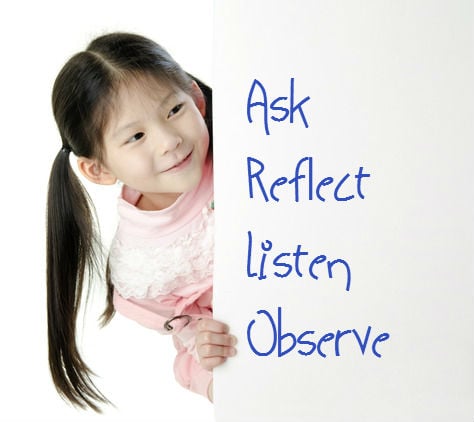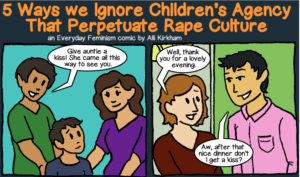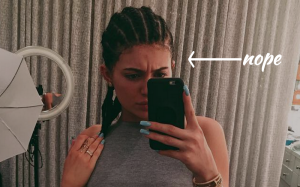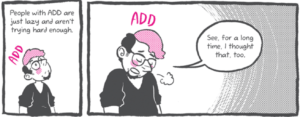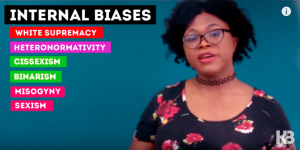Last week, I talked about starting at birth when talking to your infants about healthy sexuality. Right about the time you have that figured out, you find your child is suddenly talking and asking questions about everything.
You’ve given them the right words for their body parts and now they are going to use them to tell and ask you things about their bodies.
This is not the time to get squeamish!
It is easy to get overwhelmed by the responsibility of teaching your kids about their sexuality in a world constantly bombarding them with its own unhealthy messages.
Most of us have the best of intentions but lack the skills to implement them due to our own lack of role models and the very visceral reaction that the topic gives us.
Society’s primary methods of handling difficult questions from kids are: Tell, Minimize, Correct, and Distract.
1. Tell: When we tell, we become the teacher dumping factual information onto the child.
This doesn’t help a child come up with their own understanding and could turn them off from talking to you about the topic in the future. (“Here goes mom again with one of her lectures.”)
2. Minimize: Minimizing is endemic in our society. We tell kids they aren’t hungry, aren’t cold, are tired, etc.
When a child talks about sexuality it is easy to minimize with a “don’t be silly.” (I don’t list it separately, but beware of Minimizing’s cousin – Shaming – which is doubly as harmful).
3. Correct: Correcting is like telling but it also invalidates the child’s point of view. The purpose is to tell them they are wrong.
If you tell someone they are wrong enough times, they’ll stop coming up with their own ideas.
4. Distract: We all know what distracting is and it works famously on kids. “Look over here! Shiny object! Candy!!”
Unfortunately your child is very perceptive and will see that you distract on certain topics. Next time they just won’t broach that topic with you.
Do you recall any of these methods from when you were a kid? Did your parents or teachers ever use one of these to get out of an awkward discussion?
Navigating These Questions With The Parent/Child Dialog
Unlearning the way we were parented and what might be our initial instinct to avoid a taboo conversation is very difficult.
There is a way to replace the habits of Tell, Minimize, Correct, and Distract that can help you break out of that bad habit and forge a more open relationship with your child while they are young.
This will improve their self-esteem and make it easier for them to come to you with the even more difficult conversations when they get older.
I call this method Parent/Child Dialog. A form of dialog is often used in conflict resolution courses and marriage retreats and usually involves solving a disagreement.
Using the steps outside of disagreement not only enhances conversation but primes both of you for future conflict discussions.
Parent/Child Dialog consists of 4 techniques: Ask, Reflect, Listen, Observe (ARLO) and each of these techniques are specifically designed to help you avoid the temptation to Tell, Minimize, Correct, or Distract.
1. Ask: The best parenting tool I know is to ask questions. You will learn so much from your kids if your first response is NOT a response.
Make “You do?” and “What do you think?” your go-to responses.
2. Reflect: Reflecting what your child just said in the form of a question is a great way to deepen a conversation. It is the best way to cut short a tendency to Tell or Correct.
If he says “The sky is green!” just say “Oh, the sky is green?” instead of “No it isn’t!”
3. Listen: This is really the hardest of the 4 tools. Most of us listen on a surface level – hampered by our assumptions and our planned responses.
Dialog requires us to listen on a deeper level. Notice your reaction – your thoughts and feelings – regarding what someone says and then don’t act on them.
Remove yourself from the listening and just hear what is being said.
4. Observe: When you want to give your opinion in a conversation stop yourself and rephrase it as an observation. Observing does not have any judgment in it.
Don’t say “Yes, you do like bananas (Correcting) you ate one just the other day (Minimizing)”. Instead just say “You ate a banana yesterday.”
If you can master Dialog in conversations about sexuality, then you can probably do it with ease in other topics.
That’s the beauty of mastering the most difficult conversations!
So What Does Parent/Child Dialog Actually Look Like?
Theory can sound nice and vague so here’s some examples of Parent/Child Dialog from REAL conversations I’ve had with my own daughter:
1. “I’m going to have a penis like daddy when I grow up!”
She announced this proudly one day when she was almost 3.
Negative ways to react:
Minimize her feelings: “Don’t be silly.”
Correct her: “No you won’t.”
Tell her: “Girls don’t have penises.”
Distract her: “Uh huh. Want some candy?”
Dialog:
Me: “You are?” (Ask)
Her: “Yep! Then I can pee standing up!”
Me: “Oh, it would be cool to pee standing up, huh?” (Reflect)
Her: “Just like daddy.”
Me: “You want to be like your daddy?” (Ask)
Her: “Daddy goes to work and he’s strong.”
In using Dialog, I found out that her statement about having a penis wasn’t really about boy/girl or sexuality or even gender. She was saying she wanted to be like her daddy.
By using Dialog I gave her space to flesh out her thoughts and I validated her ideas (it would be cool to pee standing up!).
Or, let’s imagine that she was talking about gender (which is possible as a child reaches 4-6 years of age). Dialog will help you get to the root of the matter.
For example, the above conversation could have gone like this:
Dialog:
Her: “I’m going to have a penis like daddy when I grow up!”
Me: “You are?” (Ask)
Her: “Yep, I’m going to be a boy!”
Me: “You are?” (Ask)
Her: “Girls are stupid”
Ding, Ding, Ding!! By using Dialog, you’ve opened a door to discuss something much more important with her by finding a hidden prejudice.
Me: “You think girls are stupid?” (Reflect)
Her: “That’s what Tommy said.”
Me: “Hmmm, what do you think?” (Ask)
Her: (shrugs)
Me: “I’m a girl, Aunt Mandi is a girl. Do you think we are stupid?” (Observe and Ask)
Her: “No way! Aunt Mandi is super smart. She tied my shoes.”
Me: “You’re a girl too.” (Observe)
Her: (thinking) “I think Tommy was wrong.”
And so on. Dialog helped her come to the conclusion rather than shutting down conversation with “Girls are NOT stupid! Don’t let me hear you say that again!”
2. “I have a tiny penis!”
Yes, my daughter actually said this. Unfortunately many parents would have freaked out and been very uncomfortable with her exploring her body in that way.
I was just over the moon that she made the correlation between a penis and clitoris – which is biologically a very astute observation!
Negative ways to react:
Minimize (and an overreaction can turn to shame): “Get your hand out of your underpants!” or “Don’t touch yourself there!”
Correct her: “No you don’t.”
Tell her: “Girls don’t have penises.”
Distract her: “Look, fingerpaints!”
She won’t miss your alarm or attitude about this place on her body, trust me.
Dialog:
Me: “You do?” (Ask)
Her: “Yeah, look!” (shows me her clitoris)
Me: “I see. That’s called a clitoris.” (Observe)
Her: “Yeah!! My clitoris penis!”
That was the end of that. Her attitude was one of excitement over finding something new. She acted more like a great explorer than anyone with sex on their mind.
Notice I didn’t tell her what a clitoris is for or go into detail about it. She didn’t ask. I reflected her excitement and just listened providing information she needed.
However, this easy discussion about such a “forbidden” body part will make discussions about sex, masturbation, and reproduction easier when the time comes. She’ll know that no part of her body is off limits to talk to mom about.
Dialog works in so many aspects of parenting and it is a great skill to learn.
These are just some ways to start helping your child develop a sense of healthy sexuality. What are other ways you can? Please share in the comments below!
***
This article is the second in a four part series on talking to your kids about healthy sexuality. Don’t forget to check out the rest of the series!
- Let’s Talk About Sex Part I: Yes, It Starts at Birth
- Let’s Talk About Sex Part II: Your Curious Toddler and Preschooler
- Let’s Talk About Sex Part III: Ok, But Where Do Babies Come From?
- Let’s Talk About Sex Part IV: Continuing the Conversation with Your Teen
Paige Stannard is a Staff Writer for Everyday Feminism. She’s a former NASA research librarian happy to be home raising her 3 IVF babies after nearly a decade of infertility. She blogs about infertility, parenting, and women’s issues at Baby Dust Diaries as well as being the founder of the gentle discipline site ParentingGently.com and co-founder of the breastfeeding rights site NursingFreedom.org. She likes to cook and sew and has, in general, become her mother. Happily. Follow her on Twitter @babydust.
Search our 3000+ articles!
Read our articles about:
Our online racial justice training
Used by hundreds of universities, non-profits, and businesses.
Click to learn more
Most Read Articles
- « Previous
- 1
- …
- 30
- 31
- 32


